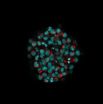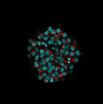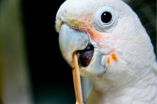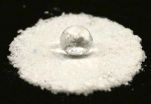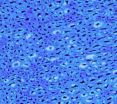(Press-News.org) VIDEO:
Using a confocal microscope, researchers can study a cleared spherical 3-D tissue culture at any depth. The video begins on the near surface and exits on the far side of...
Click here for more information.
PROVIDENCE, R.I. [Brown University] — Because Brown University biomedical engineering graduate student Molly Boutin needed to study how neural tissues grow from stem cells, she wanted to grow not just a cell culture, but a sphere-shaped one. Cells grow and interact more naturally in 3-D cultures than when they're confined to thin slides or dishes.
But the very advantage of a culture having thickness also poses a challenge: How to see all the cells and their connections all the way through the culture. It's a problem that confronts many biologists, physicians, bioengineers, drug developers- and others who also see 3-D cultures as a useful stage before moving to animal models.
"As I was imaging these tissues I was only able to get the outer layer or two of cells and that wasn't a very good representation of what was going on inside of the sphere," Boutin said.
There are inelegant ways to slice up an engineered 3-D tissue for imaging and then to reconstruct it, but a more tantalizing solution seemed likely to come from one of the chemical treatments invented in just the last few years to make tissues see-through. But which one, if any, would work with her scaffold-free engineered neural tissues? To find out, Boutin and adviser, Diane Hoffman-Kim, associate professor of medical science in the Department of Molecular Pharmacology, Physiology, and Biotechnology, decided to test the three simplest methods: ClearT2, SeeDB and Scale.
Their results – which read like a Consumer Reports article for the lab bench set – now appear online in the journal Tissue Engineering Part C: Methods.
For Boutin's critieria, the ClearT2 method turned out to be clear winner. For her little balls of neural tissue – 100 millionths of a meter in diameter – ClearT2 allowed her to see fluorescing cells at all depths of focus and, importantly, it did not change the size of the tissue. Scale made her "neural spheres" substantially larger, while SeeDB made them smaller and didn't improve clarity as much.
Maintaining the tissue culture size is important because Boutin wants to know the physical dimensions of growth in the culture, such as the axons that one neuron might extend to another.
While ClearT2 worked within 1.5 hours, Scale and SeeDB took three days, Boutin said.
She ran several further tests with ClearT2, including with other types of healthy and cancerous neural cells, and ClearT2 continued to perform well, even allowing her to image extracellular matrix.
In the paper Boutin and Hoffman-Kim acknowledge that the results with different methods may vary with different samples, but they expect that for many "scaffold-free" engineered 3-D neural tissues – tissues that grow without added matrix supports – ClearT2 should work well.
Knowing that could clear the way for many research projects with 3-D tissues.
INFORMATION:
The National Science Foundation, The National Institutes of Health, and the Brown Institute for Brain Science supported the research. Imaging occurred in Brown's Leduc Bioimaging Facility. Boutin created her 3-D cultures with technology from Microtissues Inc., a company founded by Jeffrey Morgan, professor of medical science in the Department of Molecular Pharmacology, Physiology, and Biotechnology at Brown.
A 'clear' choice for clearing 3-D cell cultures
2014-09-03
ELSE PRESS RELEASES FROM THIS DATE:
Parrots go to carpentry school
2014-09-03
This news release is available in German.
Scientists from Oxford University, the University of Vienna, and the Max Planck Institute at Seewiesen have shown that a spontaneous innovation by a Goffin's cockatoo can spread to other conspecifics by social learning.
After observing that an adult male Goffin cockatoo named Figaro spontaneously started to sculpt stick tools out of wooden aviary beams and used them for raking in nuts behind grit, the researchers wondered what effect, if any, such an individual technical invention might have on social companions. They used ...
Grooving crystal surfaces repel water
2014-09-03
Researchers from Kyoto University in Japan have developed a novel way to waterproof new functionalized materials involved in gas storage and separation by adding exterior surface grooves. Their study, published in the journal Angewandte Chemie, provides a blueprint for researchers to build similar materials involved in industrial applications, such as high performance gas separation and energy storage.
The materials, also known as porous coordination polymers (PCPs), are hollow nanoscale cage-like structures with the ability to house molecules within their empty ...
New discovery could help turn antibiotic into antimalarial drug
2014-09-03
Melbourne researchers are making progress towards new antimalarial drugs, after revealing how an antibiotic called emetine blocks the molecular machinery that produces the proteins required for malaria parasite survival.
Although emetine is effective against malaria it is not used as a preventive drug due to its significant side effects. However, the work of Walter and Eliza Hall Institute researchers Dr Wilson Wong, Dr Jake Baum and colleagues in showing how emetine attaches to and blocks the molecular machinery that makes the proteins required for malaria parasite survival ...
Sensory reinnervation of muscle spindles after TN defect repaired by autologous vein graft
2014-09-03
After complete transection of a nerve, good neuroanastomosis is needed to prevent the formation of fibrous connective tissues that form obstacles to nerve regeneration, and to facilitate repair of the injured nerve and reinnervation of its original targets. Peripheral nerve defects of more than 10 mm are commonly treated in clinics, and in these injuries a conduit is needed to bridge the gap, prevent the formation of obstacles to nerve regeneration, and guide axonal regrowth. Autogenous vein grafts have been used extensively for the repair of nerve defects in rats. Motor ...
Puerarin accelerates neural regeneration after sciatic nerve injury
2014-09-03
Puerarin is a natural isoflavone isolated from plants of the genus Pueraria and functions as a protector against cerebral ischemia. Can puerarin be involved in the repair of peripheral nerve injuries? Minfei Wu and co-workers from the Second Hospital of Jilin University in China verified that puerarin exerts an ongoing role to activate growth-associated protein 43 in the corresponding segment of the spinal cord after sciatic nerve injury, thus contributing to neural regeneration after sciatic nerve injuries. Their relevant study has been reported in the Neural Regeneration ...
Researchers demonstrate direct brain-to-brain communication in human subjects
2014-09-03
BOSTON –In a first-of-its-kind study, an international team of neuroscientists and robotics engineers have demonstrated the viability of direct brain-to-brain communication in humans. Recently published in PLOS ONE the highly novel findings describe the successful transmission of information via the internet between the intact scalps of two human subjects – located 5,000 miles apart.
"We wanted to find out if one could communicate directly between two people by reading out the brain activity from one person and injecting brain activity into the second person, and do ...
Wind energy cuts the electricity bill
2014-09-03
This news release is available in Spanish.
The UPV/EHU study analyses the electricity market in Spain during the 2008-2012 period -a time of maximum renewable penetration in Spain when energy production within the Special Scheme saw a 57% increase- and quantifies its cost.
To do this, they firstly measured the market savings produced by participating in renewable sources, and secondly, they calculated the amount paid in the form of incentives to green energy. The difference between the two figures represents the net cost of renewable energy. In contrast to other ...
Mouse studies advance treatment for common eye diseases
2014-09-03
Working with mice, a multicenter team of researchers has found a new way to reduce the abnormal blood vessel growth and leakage in the eye that accompany some eye diseases. The finding could lead to the development of new drugs for wet macular degeneration and diabetic macular edema.
The team reports their findings in the Sept. 2 issue of The Journal of Clinical Investigation.
The current standard of clinical care for wet macular degeneration and diabetic macular edema is repeated injections into the eye of antibodies against a protein called VEGF. Each injection costs ...
UNH survey: Milk prices top concern of Northeastern organic dairy farmers
2014-09-03
Northeastern organic dairy farms say their top concern is receiving steady, fair prices for their milk from milk processors, according to a new survey that is the first to assess the research and educational needs of organic dairy farmers in the region. The research is funded by the NH Agricultural Experiment Station at the University of New Hampshire College of Life Sciences and Agriculture.
While this finding won't come as news to dairy farmers, it may surprise organic milk consumers who pay considerably more for organic milk than conventional milk at the grocery. ...
Handheld scanner could make brain tumor removal more complete, reducing recurrence
2014-09-03
Cancerous brain tumors are notorious for growing back despite surgical attempts to remove them — and for leading to a dire prognosis for patients. But scientists are developing a new way to try to root out malignant cells during surgery so fewer or none get left behind to form new tumors. The method, reported in the journal ACS Nano, could someday vastly improve the outlook for patients.
Moritz F. Kircher and colleagues at Memorial Sloan Kettering Cancer Center point out that malignant brain tumors, particularly the kind known as glioblastoma multiforme (GBM), are among ...
